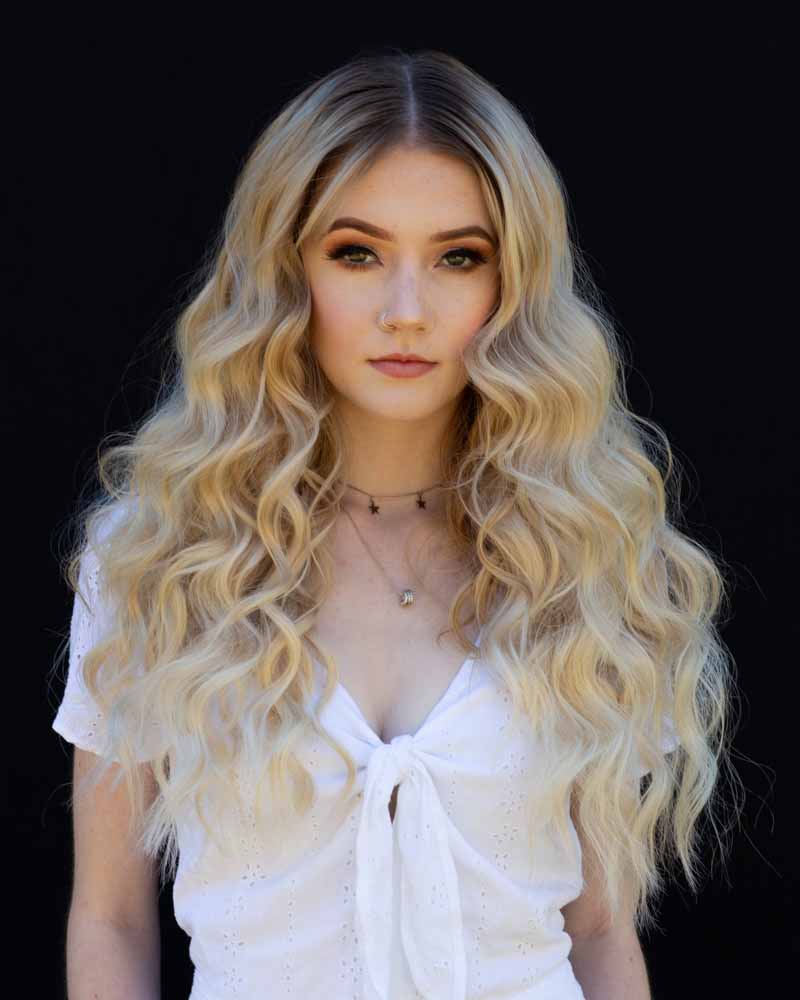Did you know that nearly 80% of DIY hair extension attempts end up in disaster? From mismatched colors to uneven lengths, the risks are high. So, before you grab those scissors and glue, pause! Let’s delve into why going the DIY route for hair extensions might not be the best idea.
Creating a seamless and natural look with hair extensions requires skill and precision that only a professional stylist can provide. Stay tuned for expert insights on why taking the DIY approach with hair extensions could leave you in a hairy situation.
Understanding Hair Extensions
Types of Hair Extensions
Hair extensions come in various types, including clip-in, tape-in, sew-in, and fusion extensions. Each type offers different attachment methods and longevity.
Clip-in extensions are temporary and easy to apply at home, while tape-in extensions require professional installation for a more seamless look. Sew-in extensions involve braiding the natural hair before attaching wefts, providing a longer-lasting option. Fusion extensions use keratin bonds to attach individual strands, offering a natural appearance but requiring maintenance every few months.
Maintenance and Upkeep
Proper maintenance is crucial for the longevity of hair extensions. Regular washing with sulfate-free shampoo and conditioner helps keep the extensions clean without damaging them.
Avoiding excessive heat styling and using heat protectant products can prevent damage to both the natural hair and the extensions. Brushing gently from the tips up to the roots with a loop brush or a wide-tooth comb helps prevent tangling and breakage.
Pros and Cons of DIY Hair Extensions
While DIY hair extensions may seem cost-effective, they come with potential risks. One advantage is the convenience of applying them at home without scheduling salon appointments.
However, improper application can lead to damage such as breakage, thinning, or even hair loss. Professional stylists have the expertise to assess the suitability of extensions for different hair types and ensure proper installation.
Consultation with a Stylist
Before getting hair extensions, it is essential to consult with a professional stylist. A stylist can assess your hair condition, texture, and lifestyle to recommend the most suitable type of extensions.
During the consultation, discuss your desired length, volume, and style to ensure that the extensions meet your expectations. A stylist can also provide guidance on aftercare routines and maintenance tips to prolong the lifespan of the extensions.
Common Myths About Extensions
Costly Maintenance
Hair extensions are often perceived as requiring expensive maintenance, but this is a misconception. While initial installation can be pricey, upkeep costs are manageable with proper care routines and occasional salon visits.
Contrary to popular belief, extensions do not always demand frequent trips to the salon for expensive touch-ups. With regular maintenance at home and professional adjustments every few months, extensions can remain in excellent condition without breaking the bank.
Damaging Natural Hair
One prevalent myth surrounding hair extensions is that they inevitably damage natural hair. However, when applied correctly by a skilled stylist and maintained properly, extensions can enhance the health of your natural hair.
Extensions should not cause damage if they are installed and removed correctly. In fact, they can provide a protective layer that shields your natural strands from daily styling stress, such as heat and manipulation.
Limited Styling Options
Another misconception is that hair extensions limit styling versatility. On the contrary, extensions open up a plethora of styling possibilities, allowing you to experiment with various lengths, textures, and colors without committing to permanent changes.
Extensions enable you to achieve diverse looks, from voluminous curls to sleek straight styles, effortlessly. They offer flexibility in creating different hairstyles for special occasions or everyday wear, catering to your evolving fashion preferences.
Uncomfortable to Wear
e individuals believe that wearing hair extensions is uncomfortable and cumbersome. However, modern extension methods prioritize comfort and seamless integration with your natural hair, ensuring a lightweight and comfortable feel throughout the day.
Innovative techniques like tape-ins and microbeads provide a secure attachment while remaining virtually undetectable. This results in a comfortable wearing experience without any added weight or discomfort on your scalp.
Risks of DIY Hair Extensions
Damage Potential
DIY hair extensions may seem cost-effective, but incorrect application can lead to severe damage. Pulling or tugging during installation can cause breakage and even hair loss.
Improper Blending
One major risk of DIY extensions is improper blending. Without professional expertise, achieving a seamless blend between natural hair and extensions can be challenging. This can result in an unnatural look.
Scalp Irritation
Improperly attached extensions can cause scalp irritation. The adhesive or clips used in DIY methods may not be suitable for all scalp types, leading to discomfort and potential allergic reactions.
Hair Quality
When opting for DIY extensions, the quality of the hair used is crucial. Low-quality hair can tangle easily, leading to frustration and difficulty in maintenance. Professional stylists use high-quality hair that lasts longer.
Maintenance Challenges
Maintaining DIY hair extensions can be challenging. Without proper knowledge, individuals may struggle with washing, styling, and overall upkeep. This can result in a shorter lifespan for the extensions.
Limited Longevity
Compared to professionally applied extensions, DIY methods often have a shorter lifespan. Due to improper installation or low-quality materials, DIY extensions may need frequent replacements, adding to the overall cost.
Risk of Infection
Improperly sanitized tools and techniques in DIY extension applications can pose a risk of infections. Without following proper hygiene practices, individuals may experience scalp infections or other related issues.
Emotional Impact
Beyond the physical risks, DIY hair extensions can also have an emotional impact. If the results are not as expected or if damage occurs, it can lead to feelings of self-consciousness and dissatisfaction.
Potential Hair Damage Explained
Lack of Professional Expertise
Many individuals attempt DIY hair extensions due to cost savings, but the lack of professional expertise can lead to disastrous results. Without proper training, mistakes like incorrect attachment methods or excessive tension on the scalp can cause severe damage.
Incorrect Application Techniques
Improper application techniques are a common pitfall of DIY hair extensions. Inadequate knowledge about proper sectioning, placement, and blending can result in visible, unnatural-looking extensions. This can lead to embarrassment and self-esteem issues for the individual.
Use of Low-Quality Products
Opting for cheap, low-quality hair extension products is a significant risk factor for potential hair damage. These products often contain harsh chemicals that can weaken the natural hair strands over time. Poor quality extensions may tangle easily, leading to breakage and further damage.
Excessive Strain on Natural Hair
One major concern with DIY hair extensions is the potential for excessive strain on the natural hair. Improper installation or maintenance can cause the extensions to pull on the roots, leading to breakage and even hair loss. This strain can also result in discomfort and pain for the individual wearing the extensions.
Lack of Proper Maintenance
Proper maintenance is crucial for the health of both the natural hair and the extensions. Without regular care such as gentle detangling, moisturizing, and avoiding heat damage, the extensions can become matted, tangled, and dull. Neglecting maintenance routines can accelerate hair damage and reduce the lifespan of the extensions.
Challenges with Fine Hair
Limited Volume
Fine hair can pose challenges when it comes to achieving the desired volume with DIY hair extensions. Due to its thin texture, fine hair may struggle to blend seamlessly with extensions, resulting in a lack of natural-looking fullness.
Difficulty in Holding Extensions
One of the primary challenges individuals with fine hair face is the ability of their hair to hold extensions securely. Fine hair tends to be slippery, making it harder for extensions to stay in place without slipping or sliding.
Risk of Damage
Individuals with fine hair are at a higher risk of experiencing damage when attempting DIY hair extensions. The delicate nature of fine hair makes it more susceptible to breakage and stress from the weight of extensions, potentially leading to hair loss.
Maintenance Struggles
Fine hair requires extra care and attention, especially when it comes to maintaining hair extensions. The fragility of fine strands can make it challenging to prevent tangling and matting, requiring frequent detangling and gentle handling.
Styling Limitations
When it comes to styling, fine hair may face limitations with DIY extensions. Achieving certain styles like intricate updos or voluminous curls can be challenging due to the limited amount of natural hair available for blending with the extensions.
Maintenance and Care Needs
Regular Maintenance
Hair extensions require regular maintenance to keep them looking their best. This includes visiting the salon for touch-ups and adjustments every few weeks. Neglecting maintenance can lead to tangling and matting.
It’s crucial to follow the specific care instructions provided by your stylist. Using the wrong products can damage the extensions and your natural hair. Regular brushing and detangling are essential to prevent knots.
Washing and Drying
Proper washing and drying techniques are vital for maintaining hair extensions. Use sulfate-free shampoo and conditioner to avoid stripping the extensions of their natural oils. Gently wash the roots while avoiding excessive rubbing.
When drying, pat the hair gently with a towel instead of rubbing vigorously. Avoid heat styling tools near the bonds to prevent damage. Air-drying is often recommended to maintain the integrity of the extensions.
Styling Tips
Styling hair extensions requires some careful considerations. Avoid pulling or tugging on the extensions when styling. Opt for heatless styling methods whenever possible to minimize damage.
Using heat protectant sprays before heat styling is crucial. Avoid high temperatures to prevent melting or loosening of the bonds. Consult with your stylist for recommended styling techniques.
Lifestyle Adjustments
Having hair extensions may require certain lifestyle adjustments. Activities like swimming in chlorinated pools, excessive sweating, or exposure to saltwater can impact the longevity of the extensions.
Consider using protective styles like braids or buns during activities that may stress the extensions. Sleeping on silk pillowcases can reduce friction and tangling while you rest.
Impact on Daily Activities
Styling Challenges
Hair extensions, when DIY-ed, can lead to styling challenges. The added weight and length might make it difficult to style your hair as usual. Simple tasks like putting your hair in a ponytail may become more time-consuming and challenging. Moreover, improper installation of extensions can cause discomfort and even headaches during daily activities.
Maintenance Struggles
Daily maintenance struggles are another issue that arises with DIY hair extensions. Improperly installed extensions can tangle easily, leading to constant detangling efforts throughout the day. This not only consumes time but also causes frustration. The use of low-quality extension products can result in shedding, making it a hassle to keep your hair looking neat and presentable.
Impact on Exercise Routine
When it comes to your exercise routine, DIY hair extensions can pose significant challenges. Sweating during workouts can cause the extensions to become loose or slip out, disrupting your focus and performance. Furthermore, certain exercises like high-intensity cardio or weightlifting may become uncomfortable with bulky or improperly secured extensions.
Social Interactions
The impact of DIY hair extensions on social interactions should not be underestimated. Unnatural-looking or poorly maintained extensions can affect your confidence during social gatherings or professional meetings. Feeling self-conscious about your hair can hinder your ability to engage with others comfortably and may even lead to avoiding social situations altogether.
Time Constraints
One of the most significant impacts of DIY hair extensions is the time constraints they impose on your daily routine. Lengthy styling sessions, frequent maintenance requirements, and the need for extra care can eat into your valuable time. This can be especially challenging for individuals with busy schedules who cannot afford to spend hours on hair care every day.
Cost Considerations
Professional Expertise
When considering hair extensions, it’s crucial to acknowledge the expertise required for a successful application. Professional stylists undergo extensive training and have experience in handling various hair types and textures. DIY attempts may result in uneven or unnatural-looking extensions due to the lack of specialized knowledge.
Quality of Materials
One key aspect often overlooked in DIY hair extensions is the quality of materials. Professional stylists use high-quality extensions that seamlessly blend with natural hair, ensuring durability and a natural appearance. On the other hand, DIY kits may contain lower-grade materials that can damage hair and lead to unsatisfactory results.
Long-Term Costs
While DIY hair extensions may seem cost-effective initially, the long-term expenses can outweigh the perceived savings. Improperly applied extensions can cause damage to natural hair, resulting in costly repairs and treatments to restore hair health. In contrast, professional installations prioritize the health of your hair, potentially saving you money in the long run.
Maintenance Requirements
Proper maintenance is crucial for the longevity of hair extensions. Professional stylists provide detailed instructions on caring for extensions, ensuring they remain in optimal condition. DIY extensions may lack proper maintenance guidance, leading to tangling, matting, or premature shedding, requiring frequent replacements and additional costs.
Closing Thoughts
In the world of hair extensions, DIY might seem like a quick fix, but the risks far outweigh the benefits. From potential damage to the challenges of maintenance and care, the road to luscious locks can be paved with pitfalls. Understanding these nuances is crucial to making informed decisions about your hair. Remember, your hair is your crowning glory, and taking shortcuts could lead to long-term regrets.
Before you dive into the world of DIY hair extensions, consider consulting a professional stylist. Their expertise can help you navigate the complexities and ensure that your hair remains healthy and vibrant. Your locks deserve the best care, so why not trust them to the hands of a skilled professional? Your future self will thank you for it.
Transform Your Look with Expert Hair Extension Stylists
Are you ready to refresh your style and boost your confidence? Step into the world of professional hair extensions at Vamp Salon Extension Studio, where your hair dreams come to life! Our talented stylists specialize in expertly applying and blending hair extensions, ensuring a flawless, natural result that enhances your beauty and adds stunning volume or length. Whether you’re looking for a subtle enhancement or a complete transformation, we offer personalized solutions tailored to your unique needs.
Why wait any longer to achieve the perfect hair look? Book Your Appointment Today and let our skilled professionals guide you through a smooth and stunning transformation. Click here to schedule your consultation, and get ready to fall in love with your revitalized style. Your journey to gorgeous, head-turning hair starts now at Vamp Salon Extension Studio!
Disclaimer
The information provided on this website is for general informational purposes only. Vamp Salon Extension Studio does not make any warranties about the completeness, reliability, and accuracy of this information. Any action you take upon the information you find on this website (vampsalon.com) is strictly at your own risk. Vamp Salon will not be liable for any losses and/or damages in connection with the use of our website. While we strive to provide accurate and up-to-date content, the beauty industry is constantly evolving, and new techniques, products, and standards may emerge. Therefore, we recommend consulting with our professional stylists for personalized advice and the latest information regarding hair extensions and other services. By using our website, you hereby consent to our disclaimer and agree to its terms. For any further questions or concerns, please contact us directly.




